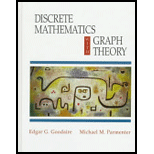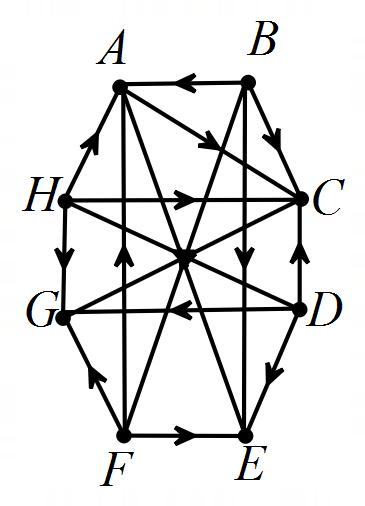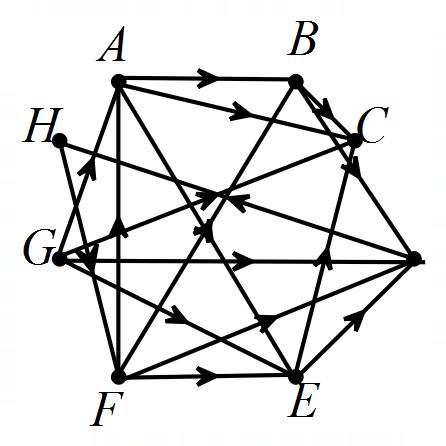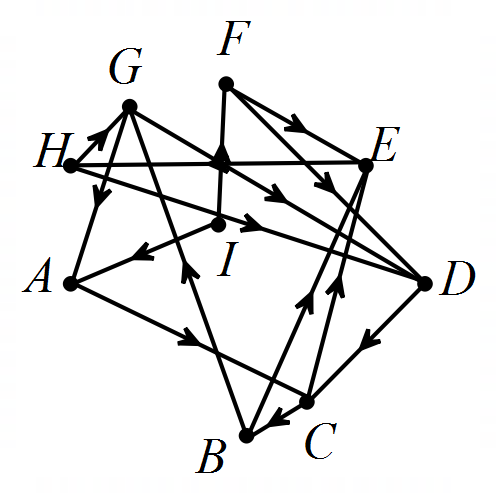
Discrete Mathematics with Graph Theory (Classic Version) (3rd Edition) (Pearson Modern Classics for Advanced Mathematics Series)
3rd Edition
ISBN: 9780134689555
Author: Edgar Goodaire, Michael Parmenter
Publisher: PEARSON
expand_more
expand_more
format_list_bulleted
Question
Chapter 12.4, Problem 1E
(a)
To determine
The given graph is acyclic by finding a canonical labeling of vertices or exhibit a cycle.

(b)
To determine
The given graph is acyclic by finding a canonical labeling of vertices or exhibit a cycle.

(c)
To determine
The given graph is acyclic by finding a canonical labeling of vertices or exhibit a cycle.

(d)
To determine
The given graph is acyclic by finding a canonical labeling of vertices or exhibit a cycle.

Expert Solution & Answer
Want to see the full answer?
Check out a sample textbook solution
Students have asked these similar questions
Use table of values to graph r = asin(3θ) to the provided image below.
Prove that a graph is two-colorable (bipartite) if and only if it contains no odd-length cycle.
Suppose α is a single cycle of length m and β is a single cycle of length n. What can be said about the order of the element αβ if α and β are disjoint cycles? If the cycles α and β share a single element in common? If the cycles α and β share two elements in common? (There are two different answers to this last question!)
Chapter 12 Solutions
Discrete Mathematics with Graph Theory (Classic Version) (3rd Edition) (Pearson Modern Classics for Advanced Mathematics Series)
Ch. 12.1 - Prob. 1TFQCh. 12.1 - Prob. 2TFQCh. 12.1 - Prob. 3TFQCh. 12.1 - Prob. 4TFQCh. 12.1 - Prob. 5TFQCh. 12.1 - Prob. 6TFQCh. 12.1 - Prob. 7TFQCh. 12.1 - Prob. 8TFQCh. 12.1 - Prob. 9TFQCh. 12.1 - Prob. 10TFQ
Ch. 12.1 - Prob. 1ECh. 12.1 - Prob. 2ECh. 12.1 - Prob. 3ECh. 12.1 - Prob. 4ECh. 12.1 - Prob. 5ECh. 12.1 - Prob. 6ECh. 12.1 - Prob. 7ECh. 12.1 - Prob. 8ECh. 12.1 - 9. The vertices in the graph represent town; the...Ch. 12.1 - Prob. 11ECh. 12.1 - 12. [BB] suppose and are two paths from a vertex...Ch. 12.1 - Prob. 13ECh. 12.1 - Prob. 14ECh. 12.1 - Prob. 15ECh. 12.1 - Prob. 16ECh. 12.1 - 17. [BB] Recall that a graph is acyclic if it has...Ch. 12.1 - Prob. 18ECh. 12.1 - Prob. 19ECh. 12.1 - Prob. 20ECh. 12.1 - Prob. 21ECh. 12.1 - Prob. 22ECh. 12.1 - The answers to exercises marked [BB] can be found...Ch. 12.1 - Prob. 24ECh. 12.1 - Prob. 25ECh. 12.1 - A forest is a graph every component of which is a...Ch. 12.1 - Prob. 27ECh. 12.2 - Prob. 1TFQCh. 12.2 - Prob. 2TFQCh. 12.2 - Prob. 3TFQCh. 12.2 - Prob. 4TFQCh. 12.2 - Prob. 5TFQCh. 12.2 - Prob. 6TFQCh. 12.2 - Prob. 7TFQCh. 12.2 - Prob. 8TFQCh. 12.2 - Prob. 9TFQCh. 12.2 - Prob. 1ECh. 12.2 - Prob. 2ECh. 12.2 - Prob. 3ECh. 12.2 - Prob. 4ECh. 12.2 - Prob. 5ECh. 12.2 - Prob. 6ECh. 12.2 - Prob. 7ECh. 12.2 - Prob. 8ECh. 12.2 - Prob. 9ECh. 12.2 - Prob. 10ECh. 12.2 - Prob. 11ECh. 12.2 - Prob. 12ECh. 12.2 - Prob. 13ECh. 12.2 - Prob. 14ECh. 12.2 - Prob. 15ECh. 12.2 - Prob. 16ECh. 12.2 - Prob. 17ECh. 12.3 - If Kruskal’s algorithm is applied to after one...Ch. 12.3 - 2. If Kruskal’s algorithm is applied to we might...Ch. 12.3 - 3. If Kruskal’s algorithm is applied to we might...Ch. 12.3 - If Prim’s algorithm is applied to after one...Ch. 12.3 - If Prims algorithm is applied to we might end up...Ch. 12.3 - If Prims algorithm is applied to we might end up...Ch. 12.3 - Prob. 7TFQCh. 12.3 - Prob. 8TFQCh. 12.3 - Prob. 9TFQCh. 12.3 - Prob. 10TFQCh. 12.3 - Prob. 1ECh. 12.3 - Prob. 2ECh. 12.3 - Prob. 3ECh. 12.3 - Prob. 4ECh. 12.3 - The answers to exercises marked [BB] can be found...Ch. 12.3 - Prob. 6ECh. 12.3 - Prob. 7ECh. 12.3 - Prob. 8ECh. 12.3 - Prob. 9ECh. 12.3 - Prob. 10ECh. 12.3 - Prob. 11ECh. 12.3 - In our discussion of the complexity of Kruskals...Ch. 12.3 - Prob. 13ECh. 12.3 - Prob. 14ECh. 12.3 - Prob. 15ECh. 12.3 - Prob. 16ECh. 12.3 - Prob. 17ECh. 12.3 - Prob. 18ECh. 12.4 - The digraph pictured by is a cyclic.Ch. 12.4 - Prob. 2TFQCh. 12.4 - Prob. 3TFQCh. 12.4 - Prob. 4TFQCh. 12.4 - Prob. 5TFQCh. 12.4 - Prob. 6TFQCh. 12.4 - Prob. 7TFQCh. 12.4 - Prob. 8TFQCh. 12.4 - Prob. 9TFQCh. 12.4 - Prob. 10TFQCh. 12.4 - Prob. 1ECh. 12.4 - Prob. 2ECh. 12.4 - Prob. 3ECh. 12.4 - Prob. 4ECh. 12.4 - 5. The algorithm described in the proof of...Ch. 12.4 - How many shortest path algorithms can you name?...Ch. 12.4 - Prob. 7ECh. 12.4 - Prob. 8ECh. 12.4 - Prob. 10ECh. 12.4 - Prob. 11ECh. 12.4 - Prob. 12ECh. 12.4 - [BB] Explain how Bellmans algorithm can be...Ch. 12.4 - Prob. 14ECh. 12.5 - Prob. 1TFQCh. 12.5 - Depth-first search has assigned labels 1 and 2 as...Ch. 12.5 - Depth-first search has assigned labels 1 and 2 as...Ch. 12.5 - Prob. 4TFQCh. 12.5 - Prob. 5TFQCh. 12.5 - Prob. 6TFQCh. 12.5 - Prob. 7TFQCh. 12.5 - Prob. 8TFQCh. 12.5 - 9. Breadth-first search (see exercise 10) has...Ch. 12.5 - Prob. 10TFQCh. 12.5 - Prob. 1ECh. 12.5 - Prob. 2ECh. 12.5 - Prob. 3ECh. 12.5 - 4. (a) [BB] Let v be a vertex in a graph G that is...Ch. 12.5 - Prob. 5ECh. 12.5 - Prob. 6ECh. 12.5 - Prob. 7ECh. 12.5 - Prob. 8ECh. 12.5 - Prob. 9ECh. 12.5 - Prob. 10ECh. 12.5 - [BB; (a)] Apply a breath-first search to each of...Ch. 12.5 - Prob. 12ECh. 12.5 - Prob. 13ECh. 12.5 - Prob. 14ECh. 12.6 - Prob. 1TFQCh. 12.6 - Prob. 2TFQCh. 12.6 - Prob. 3TFQCh. 12.6 - Prob. 4TFQCh. 12.6 - Prob. 5TFQCh. 12.6 - Prob. 6TFQCh. 12.6 - Prob. 7TFQCh. 12.6 - Prob. 8TFQCh. 12.6 - Prob. 9TFQCh. 12.6 - Prob. 10TFQCh. 12.6 - Prob. 1ECh. 12.6 - Prob. 2ECh. 12.6 - Prob. 3ECh. 12.6 - Prob. 4ECh. 12.6 - Prob. 5ECh. 12.6 - Prob. 6ECh. 12.6 - Prob. 7ECh. 12.6 - Prob. 8ECh. 12.6 - Prob. 9ECh. 12.6 - Prob. 10ECh. 12.6 - Prob. 11ECh. 12.6 - Prob. 12ECh. 12.6 - Prob. 13ECh. 12.6 - Prob. 14ECh. 12.6 - Prob. 15ECh. 12 - Prob. 1RECh. 12 - Prob. 2RECh. 12 - Prob. 3RECh. 12 - Prob. 4RECh. 12 - 5. (a) Let G be a graph with the property that...Ch. 12 - Prob. 6RECh. 12 - Prob. 7RECh. 12 - Prob. 8RECh. 12 - Prob. 9RECh. 12 - Prob. 10RECh. 12 - Prob. 11RECh. 12 - Prob. 12RECh. 12 - Prob. 13RECh. 12 - Prob. 14RECh. 12 - Prob. 15RECh. 12 - Prob. 16RECh. 12 - Prob. 17RECh. 12 - Prob. 18RECh. 12 - In each of the following graphs, a depth-first...Ch. 12 - Prob. 20RECh. 12 - Prob. 21RECh. 12 - Prob. 22RECh. 12 - Prob. 23RECh. 12 - Prob. 24RECh. 12 - Prob. 25RECh. 12 - Prob. 26RE
Knowledge Booster
Similar questions
- True or False Label each of the following statements as either true or false. 11. The order of an -cycle is .arrow_forwardExpress each permutation as a product of disjoint cycles and find the orbits of each permutationarrow_forwardConsider also the induced subgraph H of G, induced by the set of vertices {2,4,6,8,10} List all the leaves of H.arrow_forward
- Label eachof the following statement/s as either true or false. The mutually disjoint cycles of a permutation are the same as its orbits.arrow_forwardShow the graph base on the given.arrow_forwardWhich transformation produces an image that is similar, but not congruent to, its preimage?arrow_forward
- Consider also the induced subgraph H of G, induced by the set of vertices {2,4,6,8,10} List as sets of vertices the connected components of H.arrow_forwardSketch a diagram such that the vertices of △ABC lie respectively on the sides of △XYZ so that AX, BY, CZ are concurrent.arrow_forwardDetermine whether G and H are isomorphic? Also find Euler circuit, Euler trail and Hamiltonian circuit in the graph H, if possible?arrow_forward
arrow_back_ios
arrow_forward_ios
Recommended textbooks for you
 Elements Of Modern AlgebraAlgebraISBN:9781285463230Author:Gilbert, Linda, JimmiePublisher:Cengage Learning,
Elements Of Modern AlgebraAlgebraISBN:9781285463230Author:Gilbert, Linda, JimmiePublisher:Cengage Learning,

Elements Of Modern Algebra
Algebra
ISBN:9781285463230
Author:Gilbert, Linda, Jimmie
Publisher:Cengage Learning,